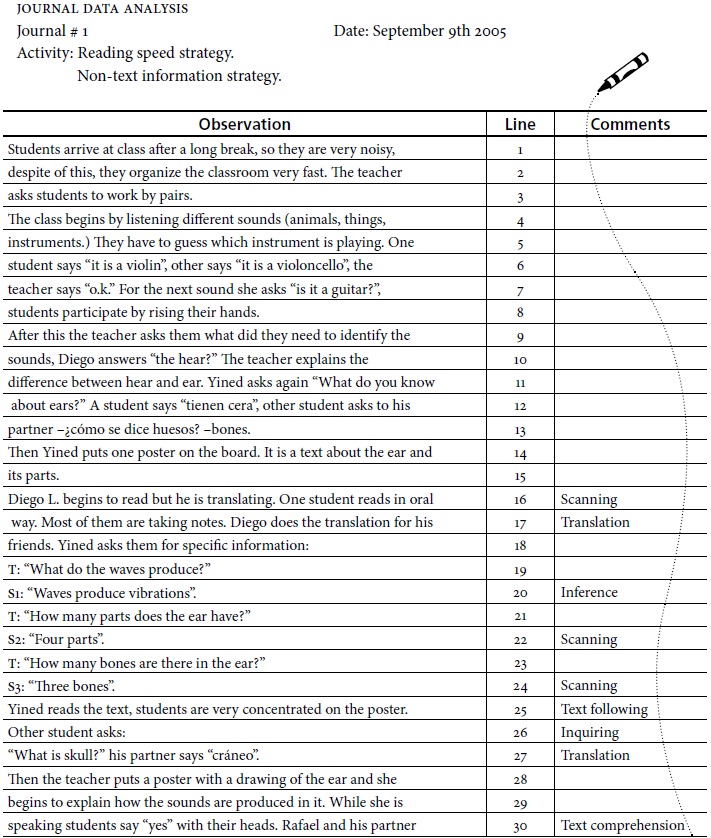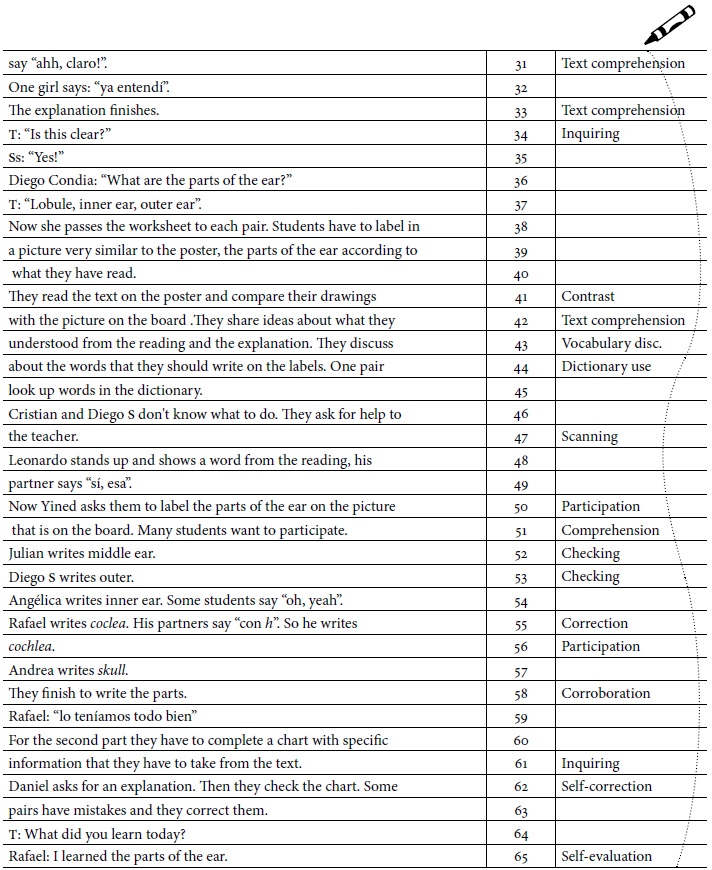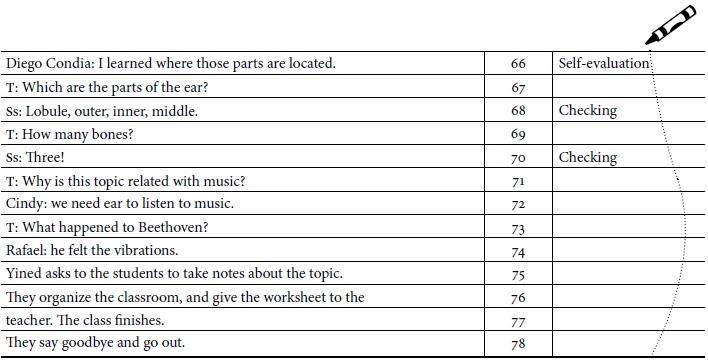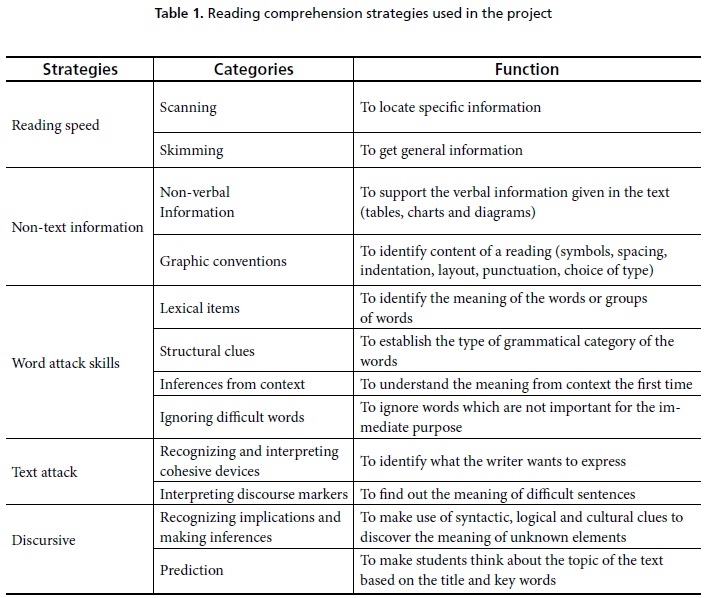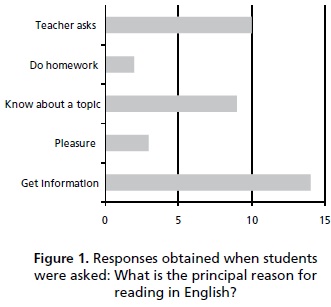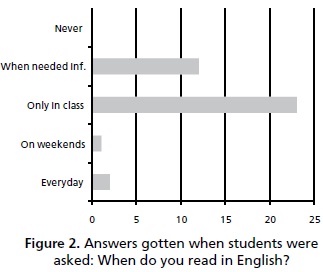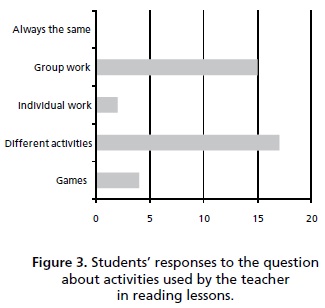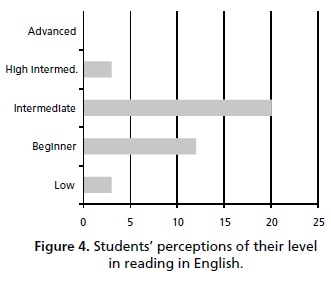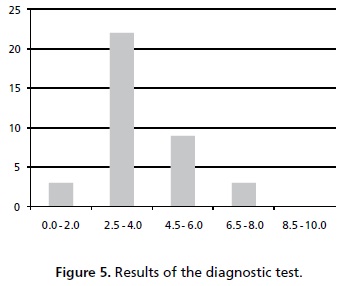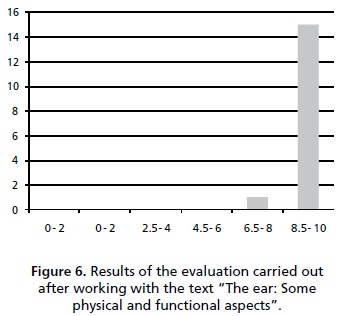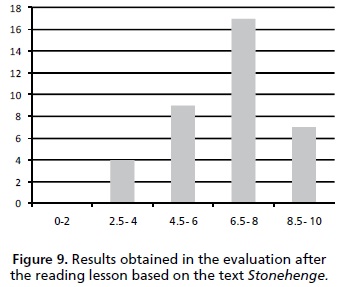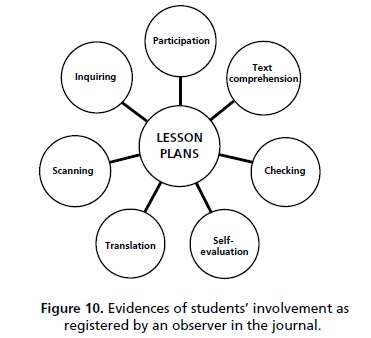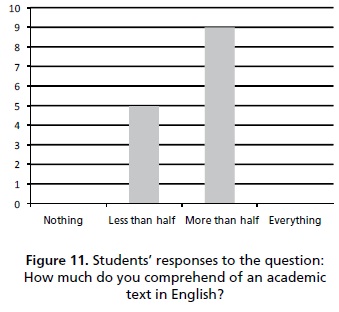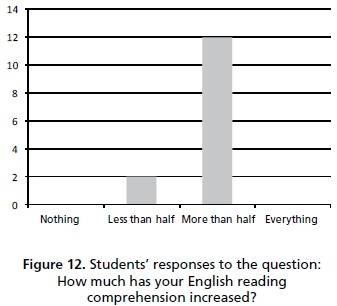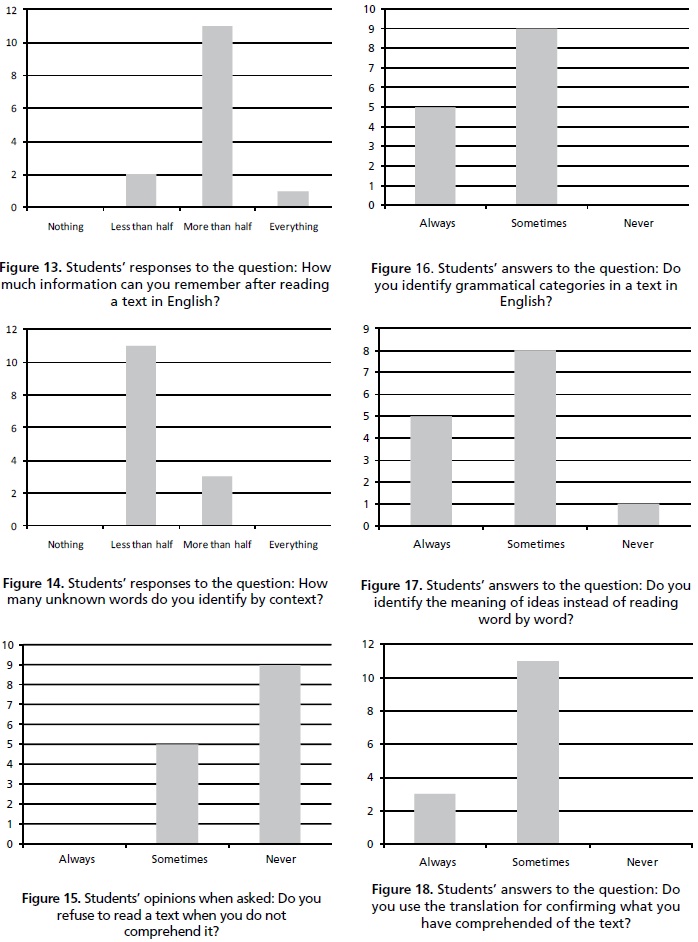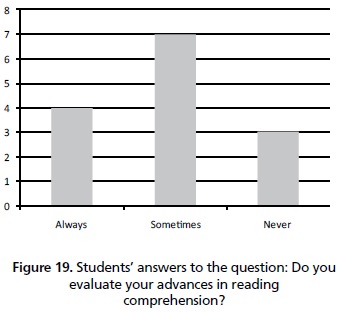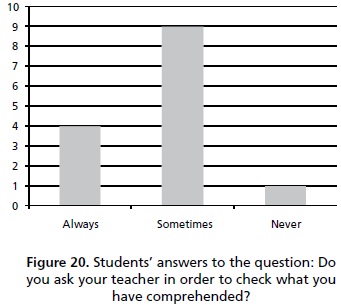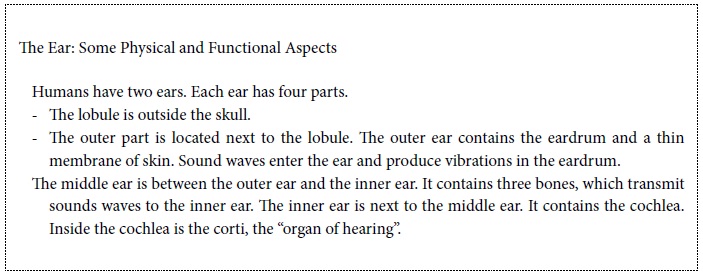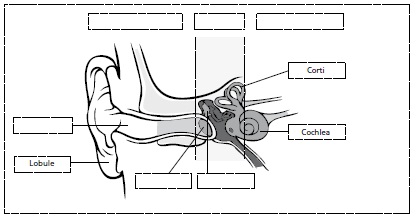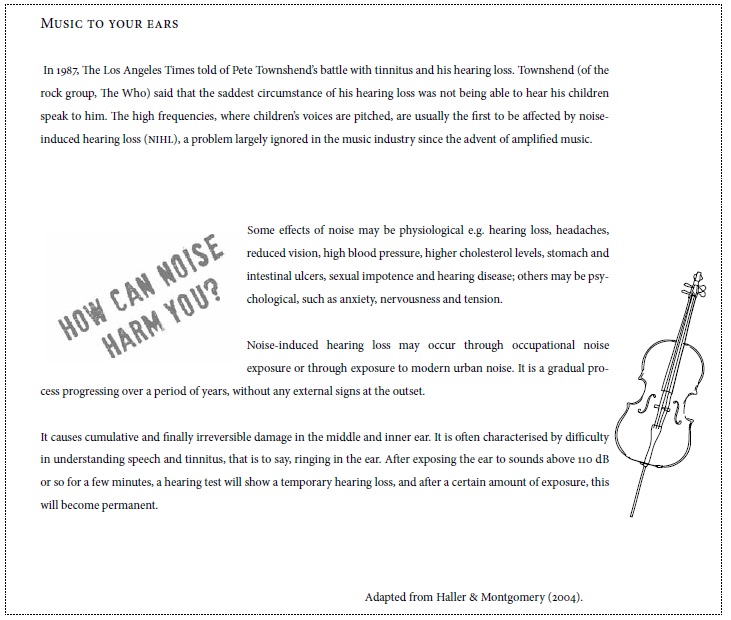Services on Demand
Journal
Article
Indicators
-
 Cited by SciELO
Cited by SciELO -
 Access statistics
Access statistics
Related links
-
 Cited by Google
Cited by Google -
 Similars in
SciELO
Similars in
SciELO -
 Similars in Google
Similars in Google
Share
Profile Issues in Teachers` Professional Development
Print version ISSN 1657-0790
profile vol.12 no.2 Bogotá July/Dec. 2010
Promoting Tenth Graders' Reading Comprehension
of Academic Texts in the English Class*
Promoción de la comprensión de lectura de textos académicos
de estudiantes de grado décimo en la clase de inglés
Claudia Quiroga Carrillo
San José de Castilla School, Colombia
claudiaquiroga2@yahoo.es
This article was received on December 5, 2009, and accepted on July 4, 2010.
This article reports on an action research project conducted in a public school in Bogotá, Colombia, with tenth grade students. We decided to develop it because of the students' needs as well as the emphasis of the PEI (Proyecto Educativo Institucional = School Institutional Project), which is based on the requisite of improving reading comprehension. The project focused on the implementation of four lesson plans in which five reading strategies were applied. They were reading speed, non-text information, word attack skills, text attack and discursive strategies. Data collection was conducted by using observation, journals, interviews and questionnaires. These instruments provided information about the level of improvement in reading comprehension and evidenced advances in the students' performance when they read an academic text in English.
Key words: Reading strategies, reading comprehension, academic texts.
El presente artículo trata sobre un proyecto de investigación-acción llevado a cabo en un colegio público de Bogotá, Colombia, con estudiantes de décimo grado. Decidimos desarrollarlo tanto por las necesidades de los estudiantes como por el énfasis del PEI (Proyecto Educativo Institucional), el cual se basa en el mejoramiento de la comprensión lectora. El proyecto se centró en el desarrollo de cuatro sesiones de clase en las que se fomentó el uso de cinco estrategias: velocidad de lectura, información no textual, abordaje de palabras, abordaje del texto y estrategias discursivas. La recolección de datos se realizó a través de la observación, diarios de campo, entrevistas y cuestionarios. Estos instrumentos suministraron información sobre el progreso en la comprensión de lectura y evidenciaron avances en el desempeño de los estudiantes al abordar un texto académico en inglés.
Palabras clave: estrategias de lectura, comprensión de lectura, textos académicos.
Introduction
Our students are required to make use of material in English for academic purposes. However, reading has been seen as a students' weakness in their academic performance as well as in the results of the ICFES exam 1. They have not been the best. It is then our responsibility to give students some elements to improve their reading comprehension skills and, hopefully, have an impact on the results they get on that exam.
Having this in mind and taking into account that our school is interested in fostering higher command of the English language, a group of English teachers decided to take a teacher development program at Universidad Nacional de Colombia in Bogotá. Along this program we engaged in the development of a project called "Let's read and comprehend academic texts" so that students could improve their reading comprehension of academic texts through the appropriate application of reading strategies. The long-term goal was also that this project continues as an important task to be developed by all the English teachers in our school.
We know that Colombia is not a country of true readers and our students did not comprehend reading passages very well, even in our mother tongue, Spanish. In addition, most of them did not like to read even in Spanish.
For that reason we considered this project could help not only students but also colleagues with the achievement of new ways for getting best results in reading comprehension. In the following paragraphs we present the focus of our study, the theoretical framework which was illuminated by Nuttall (1982). There we define the following five reading strategies we chose: reading speed, non-text information, word attack skills, text attack, and discursive strategies. Then the way we approached the lesson plans will be shown as well as the results and findings obtained at the end of this experience.
The Focus of Our Study
Which reading strategies can be implemented in tenth grade at San José de Castilla School to have 10th grade students comprehend academic texts in English? This is the question that led the project in order to develop reading comprehension in academic texts because the main needs of the students are related to reading instructions, obtaining information from the internet, admission to universities, and getting jobs, among others.
Theoretical Framework
The theoretical bases considered in order to get a solid foundation for our research were basically those that deal with reading strategies, reading comprehension and academic texts.
Reading Comprehension and Academic Texts
Reading comprehension is the process of constructing meaning from a text. It involves decoding the writer's words taking into account background knowledge. It means the reader's knowledge of the topic, of language structures, of text structure and genders, which help him/her understand the message. The process is also affected by motivation, the quality of the reading material and the strategies used. Likewise, there are many factors that affect reading comprehension; for instance, students with low language skills and low development of the strategies required to decode a text.
According to Bernárdez (1982), a text is the fundamental linguistic unit, a product of verbal human activity. Its main features are semantics and communication, but also its coherence that is formed from the speaker's communicative intention in order to create an unabridged and structured text.
When we talk about academic texts we refer to those texts that circulate in schools and that are related to an expert's knowledge. One of her/his main functions is to explain (comprehend something, modify a stage) or to demonstrate knowledge.
The majority of texts that students approach are academic ones. These texts have specific characteristics, very different from oral or written discourses, such as written reports, exams, notes, presentations, summaries, diagrams, outlines, reports, reviews, descriptions. In connection with this, Pérez Grajales (1999) states some features, to wit: (1) The general purpose is to show knowledge, (2) its content is based on lectures, presentations, experiments; and (3) the recipient of the text is the student.
The kinds of texts that students use in the English classroom are generally news, letters, postcards, articles, internet information, essays, and so on. Because of this, it is important to teach students how to process information provided in academic texts so that they can have the opportunity to move forward in their learning in any area from the school curriculum.
Reading Strategies
Reading strategies are necessary to successfully comprehend texts. Cohen (1990, p. 83) distinguishes skills and strategies: "skill is an overall behavior or general class of behaviors and strategy is the specific means for realizing that behavior". On the other hand, Barnet, in Jiménez (2000, p. 34), defines reading strategies as the mental process involved in accomplishing reading tasks. As can be seen, the goal of a specific strategy is to understand a text easily and students must be given opportunities to develop reading strategies effectively so that they can process different kinds of texts.
Based on our students' most relevant needs in reading, and following the typology presented by Nuttall (1982) and Jiménez (2000), five strategies were chosen. Reading speed, non-text information, word-attack skills, and text-attack skills were considered useful in order to reach positive results in reading comprehension. In each one of them we have some categories; that is to say, strategies that were chosen to guide the students along the reading comprehension processes developed in class. They are gathered in Table 1 and briefly explained in the following paragraphs.
Reading Speed
As reading involves understanding and is the cause of speed, the speed depends on understanding. Nuttall (1982) states that speed is useful, but not the main criterion. In addition, reading speed should not be developed as the most important part of comprehension. Scanning and skimming skills help students to improve their speed in reading.
It should be clarified that scanning deals with a rapid look in order to search for specific information or to get the required purpose. It also helps to identify what information is relevant for a specific purpose. Skimming, in contrast, refers to looking over a reading passage quickly to get general information. It helps to find out what the text is about.
Non-Text Information
It refers to the use of information that is not specifically included in the text. Nuttall (1982) states three categories connected to this strategy:
- Reference apparatus, which makes reference to what can be learnt from a book before reading it. It refers to the parts of a text that can help the reader to locate information or predict what the text contains.
- Non-verbal information, which, in the authors' words, is the information included in tables, charts and diagrams. It is also the information that accompanies the text but is not considered textual.
- Graphic conventions could be obvious for students but they need practice in identifying them in order to clarify and understand the texts (symbols, indentation, layout, punctuation, choice of type).
Word-Attack Skills
It is related to the way we tackle difficult lexical items. We can do so through lexical items, structural clues, ignoring difficult words, and using a dictionary. Lexical items refer to any word or group of words with a meaning that students have to learn as a whole (Nuttall, 1982). Structural clues establish the grammatical category of the words whereas inference from context deals with getting the meaning of a word by making use of the context in which it occurs (Jiménez, 2000). On the other hand, we can ignore the words that are not relevant for a specific purpose in the reading or use a dictionary. This last strategy is important because students should know the correct use of the dictionary in order to save time and avoid interruptions when reading.
Text-Attack Skills
They are the ones that help us grasp some features of the text such as cohesion, functional value, and rhetorical organization. To do so we can use the following skills: understanding sentence syntax, recognizing and interpreting cohesive devices, and interpreting discourse markers. Markers like linking words, connectors, discourse organization, and writers' points of view relate the parts of the text and indicate the functional value of the sentence (Nuttall, 1982).
Discursive Skills
In this group we have those skills related to recognizing information that is not explicitly stated in the text. Skills associated with discourse are as follows:
- Recognizing the functional value: It deals with recognizing not only the meaning or the signification, but also what the writer intends to do with the utterances used in the text.
- Interpreting rhetorical structure: This refers to the structure of the underlying ideas and the connections between them. As noted by Nut-tall (1982), it is important to analyze the organization of aspects like content, information within a sentence, sequence of sentences and paragraphs.
- Recognizing the presuppositions underlying a text: This is related to the presuppositions that both writers and students could have when they read and understand the text.
- Recognizing implications and making inferences: This refers to the inferences students can make from other pieces of information in the text.
- Prediction: This skill embraces the ability to predict and helps students to understand the text (Jiménez, 2000).
Context and Participants
The I.E.D. San José de Castilla is a public school located in Castilla neighborhood, eighth zone, in Bogotá, Colombia. The school offers education from kindergarten to eleventh grade in four different places. In high school there is an average of forty-five students per class. The group chosen was one of the tenth grades, classroom 1002. It consisted of thirty-eight students: 21 boys and 17 girls. They were from 14 to 17 years old and had different English levels.
Method: How Action Research Was Implemented
Diagnostic Phase
At the beginning of the project we carried out a diagnostic task. To do so, we first applied a questionnaire in order to state the reasons for reading texts in English, how important reading in English was for students, the techniques most used when reading, and their reading comprehension level. Next we gathered the main results of this base-line phase of our study. First, in Figure 1, we can read what students said about the reasons for reading in English.
The main reason for reading texts in English was to get information and to fulfill a requirement set out by the teacher. The analysis of the information we gathered also showed that most of the students only read texts in English in class (see Figure 2). This made us hypothesize that the students only read in English classes because they do not have or do not know how to use the strategies in order to process a reading text on their own. This confirmed that they needed some orientation for tackling a text.
In regard to the use of different techniques used by the teacher in the English class, we also found a variety of practices, as can be seen in Figure 3.
As shown in Figure 3, when asked about the ways they used to approach a text in the reading lessons, students stated that teachers explored different alternatives. Furthermore, students highlighted that collaborative work played an important role in their lessons.
We also asked students, "What do you think your reading level is?" and could identify a variety of responses in regard to their reading comprehension. Their responses can be seen in Figure 4.
However, and as can be read afterwards, a diagnostic test we also administered in order to establish the real reading level of the students showed that the students' real level was very low (see Figure 5). It was a big problem and a cause of concern if we take into account that the students had studied English for at least five years.
The diagnostic test was applied to 37 students and the results were scored from 0 to 10, being 0 the lowest score and 10 the highest one. In this test we included some questions intended to find out if they used the five strategies we had planned to apply in the project. We wanted to establish if students were familiar with them or not. To do so, a biology text related to the photosynthesis process was chosen.
The test results confirmed that although the majority of the students considered their level to be high, they had a low reading comprehension level when required to answer questions about an academic text. In addition, in the responses to the diagnostic questionnaire we found that 60 per cent of them read in English only in class, and only when the teacher asked them to do so. That was why it was very important to develop a special project on reading comprehension.
Data Collection
When doing an action research project, it is important to choose data collection techniques in order to identify and justify monitoring or observing what happens in connection with the research problem itself (Burns, 1999). That is why we decided to use a journal and questionnaires as the main techniques or instruments. Likewise, we chose interviews and artifacts (reading worksheets) as complementary sources. In the following paragraphs we explain what we understand by each instrument and how they were used along the research study.
A journal is a public document in which information about the class is registered in order to collect data related to the development of the class, activities, events, feelings, reactions, reflections, and explanations. In our case, there were two teachers in the classroom; while one of them was doing the class observation and taking notes about the class environment, the students' behavior, and the way they used the reading strategies, the other was directing the class, leading students to fulfill the lesson and applying the strategies selected for the specific class. The monitoring was very meticulous (see one sample in Appendix 2).
As we know, a questionnaire is a form containing a set of questions for gathering information. Its goal is to ask people about their knowledge, opinions, ideas and experiences in order to get data for reflection and analysis of a specific topic. In this research, two questionnaires were used. With the first we wanted to identify how important reading was for students and how the reading process was held in class. It was applied before beginning the project. With the second one we wanted to state the students' reading comprehension level in English; it was also applied at the beginning of the process.
Like the questionnaire, the interview is an instrument that helps the researcher to get information about participants' opinions and experiences. We prepared the interview to be answered in writing. One interview was applied in the middle of the process in order to determine the advances of the project.
Finally, artifacts consisted of the work produced by students during the lessons. The first lesson plan was prepared to have students apply the reading speed strategy in order to develop the scanning and skimming skills to get specific and general information. They also applied the non-verbal information strategy to fill in charts and to label a scheme. In the second lesson plan students applied the non-text information strategy in order to develop their capacity to understand graphic conventions.
For the third lesson plan students applied the reading speed and text-attack strategies for getting specific and general information. Students also identified what the writer wanted to express and found out the meaning of difficult sentences.
For the last lesson plan students applied text-attack and discursive strategies in order to find out the meaning of difficult sentences and to make use of syntactical, logical and cultural clues. Students were expected to discover the meaning of unknown elements.
These data techniques allowed us the possibility to see the students' behaviors or answers when asked which reading strategies they applied. In addition, we could contrast specific information in order to make the project objective and reliable. Through the analysis of data provided by said instruments we could check the effectiveness of the proposal.
Pedagogical Procedure
According to the students' needs and in order to improve their reading comprehension skills, we prepared four lesson plans and thought of activities that would encourage them to apply the strategies described beforehand: reading speed, non text information, word-attack, text-attack, and discursive.
For the lesson plan design we took into account three stages each one with specific steps. They are shown in Table 2.
Appendix 1 includes a sample of one of the lesson plans designed by the teachers involved in the project, and which was developed with the group of students participating in our study.
Findings
Through the analysis of the different instruments used in our research, and which were mentioned before, we could identify three themes that are discussed in the following paragraphs: (1) using reading strategies to decode academic texts; (2) students' involvement in the reading lessons; and (3) difficulties and challenges along the process.
Using Reading Strategies to Decode Academic Texts
As already mentioned, for the purpose of our project five reading strategies were selected in order to design four lesson plans. Each lesson plan intended to have students explore the use of one or two reading strategies. On the other hand, there was also an evaluation at the end of each lesson in order to determine the students' performance or progress in reading comprehension.
For the first lesson a biology text was used: "The ear: Some physical and functional aspects". The text was about how noise can induce hearing loss. The students worked with labels, charts, pictures and abbreviations. The strategies selected were reading speed to locate specific information and to get general information; and non-text information to identify content of a reading and to support the verbal information given in the text.
It is important to say that the students worked in pairs. Another important aspect is that they did not use the dictionary at all because the visual aids, as The ear poster, and some mimics used by the teacher helped students to comprehend the text. As shown in Figure 6, the results of the evaluation carried out at the end of the lesson showed that most of the students felt confident when they used reading speed (scanning and skimming). They also used a scheme in order to clarify their comprehension about a text.
The strategies selected for the second lesson were reading speed, and word-attack skills to identify the meaning of the words or sentences in the reading. Music was the chosen topic and the text was Ludwig van Beethoven. In the first part of the worksheet used for the lesson, the students could read a text of his biography. In the second part, there was a chart with some information taken from the Internet. The students worked with vocabulary from the context and filled in charts. They were also challenged to find definitions or synonyms.
The low grades obtained in the evaluation (see Figure 7) showed that the majority of the students had some difficulties identifying the meaning of unknown words in the context and the "fill in charts" task was not easy either. In this lesson, the students had to use the dictionary. They did so by pairs.

From these results we could state that word-attack skills are useful only when students have a wide range of vocabulary. Also, it was concluded that they needed more opportunities to practice those skills with concrete tasks and teachers' guidance.
The third lesson plan included a cultural topic. The text chosen was Television, its advantages and disadvantages. The students worked with a long text, doing exercises about vocabulary. They also worked main ideas and text organization. The strategies selected were word-attack skills, in order to reinforce this strategy, and text-attack, to identify what the writer wants to express and to find out the meaning of difficult sentences.
The results showed better grades than in the previous lesson (see Figure 8). Students worked in pairs and understood the vocabulary in the text. The strategies applied seemed to help them with general comprehension. In this lesson, students were more interested in the topic, so we could establish that this was an important aspect for comprehension. Hence, the topics of the texts have an impact on students' motivation.
 .
. The last lesson was related to geography. The text used was entitled Stonehenge. In it, students could read about this megalithic monument. The class had a jigsaw activity, predictions, diagrams and maps. The strategies worked were text-attack to find out the meaning of difficult sentences and discursive to make use of syntactical, logical and cultural clues to discover the meaning of unknown elements.
The results gathered in the evaluation of the fourth lesson (see Figure 9) showed that students understood most of the text and improved their grades. At this point students had used not only the specific strategies for the lesson plan, but also a combination of all of the five that were chosen for the project.
Students' Involvement in the Reading Lessons
As already explained, we used a journal (see Appendix 2) as a way to collect information. Through the observations carried out by an observer -by one of the teachers participating in the development of the project- we could keep records of some actions and students' behaviors during the development of every lesson. Figure 10 gathers the evidence of students' participation throughout the process. They are explained afterwards.
Participation
Participation was a constant in the four lessons. It shows that students were active in the learning and comprehension process, and it was also a way to confirm if the strategies applied were working. Students felt confident to make comments during the classes in order to corroborate, read, give opinions, ask or give meanings for words or sentences in the text.
Text Comprehension
Although students' performance in the evaluations carried out at the end of the lessons were not always high, text comprehension was a constant pattern in the observations registered in the journal. Text comprehension was a theme that gave us the basis to see the effectiveness of the strategies worked in each class and along the different processes of our study. Text comprehension was present in the development of the lesson plans. It was the focus of attention in all of them and an indicator of students' understanding or difficulties to decode the contents of specific texts.
Checking
This topic was also a constant in the implementation of the project because it was used by both students and the teacher as a tool to confirm, correct or corroborate the information that students got in a text. This was carried out not only in an individual way, but also in group work.
Self-Evaluation
During the process students did self-evaluation in a tacit way. In several cases, we could observe they corrected themselves after checking specific tasks or activities and also when they finished the evaluation of each lesson.
Scanning
This was a skill that most of the students used in order to get a general idea from a text. Along the processes of the different lessons, they learned how to use it and how to take advantage of it.
Translation
This tool was used in order to confirm if the meanings or ideas that students had of a text were correct. Translation was done by looking at the context of given words and the use of the dictionary as a resource to understand some vocabulary that was not very common.
Inquiry
Students used inquiry as a way to corroborate, confirm or change their opinions or questions about a text. They not only posed questions for the teacher, but also asked their classmates for help. Besides, it was a tool to clarify general ideas, meanings or uses of a specific part of a text.
Difficulties and Challenges along the Process
The analysis of the information collected in our study also indicated that students had difficulties when filling in tables. This shows that the non-text information strategy was not easy for them. Additionally, we noticed that the use of the dictionary was less frequent because they identified many words from context or preferred to translate them. Nonetheless, students demonstrated that the word-attack skill was successful after two lesson plans.
They did not only use the five strategies defined in the literature review, but used other strategies such as translation, inquiry, and checking. All of them were tools brought into play in order to find out the meaning of the text. At this point, the teacher's role was very important because through inquiring and checking she confirmed or clarified information. About the students' role, the use of reading tools, that is to say, strategies, helped them to play an active role and thus decode information contained in academic texts, extract the required data and fulfill goals with more efficiency.
As explained before, we used interviews as complementary sources to monitor the reading lessons. An interview was applied in the middle of the research process to a sample of 14 students and in order to determine the progress of the project and students' opinions about the reading comprehension lessons.
The responses gathered showed how the project offered the students elements in order to improve their comprehension of academic texts. Also, findings posed challenges for both the teachers and the students in the following lessons and in reading lessons in general. Let us summarize what we found in the interviews. Also, we can see the corresponding statistics in Figures 11 to 20.
Most of the students considered that at this point of the process -in the middle of project development- they could comprehend more than half of a text. They also considered that their reading comprehension had increased.On the other hand, most students expressed that after reading a text they could keep in their minds or remember more than half of the information contained in it. In contrast, the students' responses to the question How many unknown words do you identify by context? indicated that it was difficult for them to identify words by context. However, and as can be seen in Figure 15, when students did not comprehend a text, they tried to read it. This shows that they were willing to face the challenges reading texts posed despite the difficulties they might have had with a lack of vocabulary.
On the other hand, the fact that all the students were able to identify grammatical categories in a text indicated that the analysis of the passage structure was a source to decode it. Likewise, although for them it was difficult to identify words from context, it was easier to get the meaning of a whole idea, instead of paying attention to word after word.
In regard to the use of the mother tongue, all the students admitted they used translation in order to confirm that they comprehended a text. Furthermore, most students expressed sometimes or always evaluating their advances in reading comprehension. Finally, it was interesting to find that most students admitted they asked the teacher in order to check their answers to reading tasks; in other words, to know whether what they comprehended was right.
Conclusion and Implications
Students had the opportunity to work with reading strategies and recognized those that helped them in their reading comprehension. For instance, they were more conscious of the importance of looking at titles, pictures and other visuals in order to identify the information they provided. Also, they learned how important it was to get a general idea about the text. Similarly, the students recognized that identifying the key words allowed them to find information in a short period of time.
The results achieved with the implementation of the project showed that the five strategies chosen for developing reading comprehension skills of academic texts were useful for students. However, it is necessary to help them to discover which ones are the best in order to obtain better results.
Some strategies were difficult for students so it was necessary to work with them in different classes in order to reinforce all of them. The idea is that they get into the habit of using reading strategies.
The dictionary cannot be seen as the first tool to comprehend. Encouraging the students' to look up only a few unknown words in the dictionary enables them to find other ways to understand. Of course, it is necessary to work with the appropriate vocabulary techniques such as getting meanings by context so that they can discover or experiment with different reading strategies.
We exploited academic texts for the present project. When a person reads, s/he expands her/ his vocabulary and improves her/his general knowledge. Moreover, it makes comprehension easier. The use of different types of texts not only strengthened our students' knowledge about the language, the reading strategies or the topics contained in them, but also contributed to having more dynamic classes.
When the learning process is not just a process, but one also analyzed and systematized by using different data techniques, our pedagogical practice improves and it is possible to get a real view of the difficulties and advances of the students. The results showed the effectiveness of the project, because the students got better grades when we developed each new lesson plan, so we could conclude that the students improved their academic performance.
This project allowed the achievement of new actions in the reading comprehension processes; the most important action for us has been the engagement of other English teachers in the application of the project. This way, we have supported the emphasis of our PEI.
Reading is a long process so it is necessary to work with reading strategies for a longer period of time in order to get better results and to make sure students get familiar with them. The present project was allocated only two months to be developed. Thus, it was recommended that the school extend it, to improve it and to implement it afterwards.
It is important to state that since we began with this project (in 2005), it has been enriched year by year, and has helped our students to get better results in the ICFES exam. This was recognized later at the national level and our school got a prize for being the third best results in English in the ICFES test, in 2007. Because of this, our school was chosen for taking part in the Secretary of Education of Bogotá Distrito program related to specialized high school education, which aims at giving students in 10th and 11th grades the opportunity of intensifying the English classes with academic purposes -which means taking more hours of English per week- so that they can have better opportunities for university admission, travelling, getting scholarships abroad, and better performances on academic tasks.
* This paper reports on a study conducted by the author while participating in the PROFILE Teacher Development Program at Universidad Nacional de Colombia in 2005. It was a collaborative work conducted by the author of this paper with Azucena Acosta, Martha Buitrago and Yined Padilla. The Teacher Development Program was sponsored by Secretaría de Educación de Bogotá, D.C. Code number: 033, May 6, 2005.
1 Students who are about to finish high school are required to sit a test which is administered by ICFES (Instituto Colombiano para el Fomento de la Educación Superior), which is the national institute for educational evaluation and testing in Colombia.
References
Bernárdez, E. (1982). Introducción a la lingüística del texto. Madrid: Espasa-Calpe. [ Links ]
Burns, A. (1999). Collaborative action research for English language teachers. Cambridge: Cambridge University Press. [ Links ]
Cohen, A. (1990). Language learning: Insights for learners, teachers, and researchers. New York: Newbury House. [ Links ]
Haller, A. K., & Montgomery, J. K. (2004). Noise-induced hearing loss in children. What educators need to know. Retrieved August 20, 2010, from: http://www.speechandlanguage.com/PDF/june20042.pdf. [ Links ]
Jiménez, P. (2000). Teaching reading strategies. Bogotá: Editorial Universidad Externado de Colombia - Colciencias. [ Links ]
Nuttall, C. (1982). Teaching reading skills in a foreign language. London: Heinemann. [ Links ]
Pérez Grajales, H. (1999). Comunicación escrita. Madrid: Espasa-Calpe. [ Links ]
About the Author
Claudia Quiroga Carrillo holds a B.Ed in English-Spanish from Universidad Distrital Francisco José de Caldas. She teaches English in 10th and 11th grades at San José de Castilla School, afternoon shift, in Bogotá, Colombia.
Appendix 1: Sample of a Lesson Plan
>Lesson plan 1
Level: Tenth
Ages: 14 to 17
Class: 1
Goal: To apply the non-text strategy in order to identify content of a reading and to support the verbal information given in the text.
Strategy: Non-text information.
Materials: Tape-recorder, CDs, posters (a drawing and a text), worksheet, text -The hearing loss.
Time Guide: 2 sessions.
Before Reading
Warm up: 10 minutes.
- The students will listen to different kind of sounds e.g. water, birds, bulls, dogs, wind, drums and so on. They will try to discover what sound they are listening to.
- The teacher will ask the students:
-What is the sense they used to discover those sounds?
-Is it important? Why?
-The students will give their opinions.Presentation: 10 minutes.
- The teacher will display posters about the ear on the board.
- The teacher will read the text and show the different parts of the ear in the drawing. She will explain or clarify its meaning if necessary.
While Reading
Warm up: 65 minutes
Practice:
A.The ear
- The students will work in pairs. The teacher will give a worksheet for each student. The students will be asked to label the diagram and to complete the summary.
- The teacher will monitor the activity and help if necessary.
- The teacher will draw the chart on the board.
- One student from each group will go to the board and complete the diagram on the poster or will fill in the chart. If it is not correct another student can help him/her.
Worksheet
Diagram: Label the diagram
Summary: Complete the table
B. Music to your ears?
1. The students will receive a copy of the text to work with. They will read the text with their partners' help and get a general idea.
2. The teacher will ask students specific information.
- When was the article published?
- Where was the article published?
- What was the rock group's name?
- What does 110 dB cause?3. The students will read the text again in order to understand it better.
4. The teacher will ask students general information and the students participate randomly.
5. The students will read the prevention for hearing loss and will solve the activity on their worksheets.
6. When the students finish, the teacher will select some of them in order to read aloud the answers and correct them.
- What is the meaning of NIHL?
- Who/What did the article talk about?
- What physiological effects can noise produce?
- What psychological effects can noise produce?
- Where is irreversible damage produced?
After Reading
Evaluation: 20 minutes Name: _________________________________ Date: _________________________________
1. Write true (T) or false (F).
a.The article about Townshend helped to raise public awareness of NIHL. ____
b. Hearing loss is only one of the effects of noise on health. ____
c. NIHL can be acquired or it can be congenital. ____
d. A person may not realize for a long time that s/he is suffering from NIHL. ____
e. Only people working in noisy environments suffer from hearing loss. ____
f. The degree of damage in the ear can only be determined through hearing tests or audiograms. ____
2. Complete the chart according to the information in the text.
3. Complete the table.

Appendix 2: Journal Sample. Records Gathered when Lesson Plan 1 Was Developed
